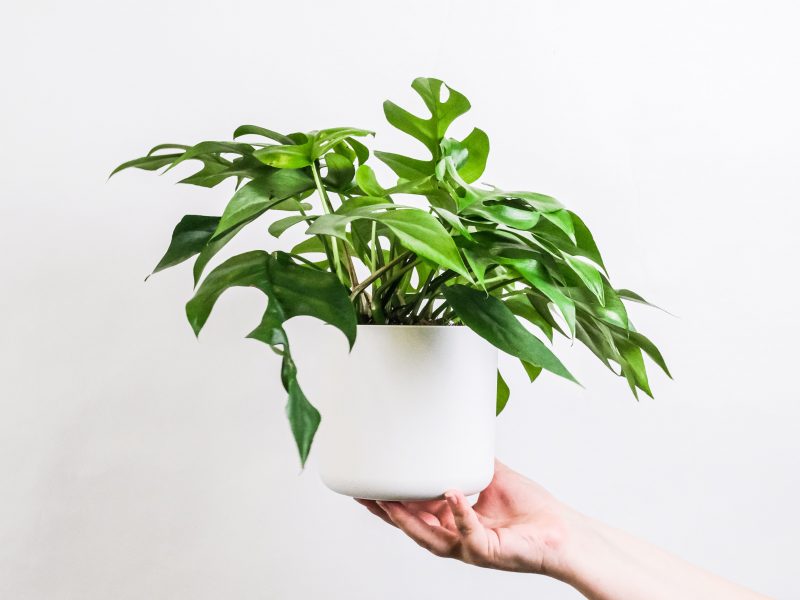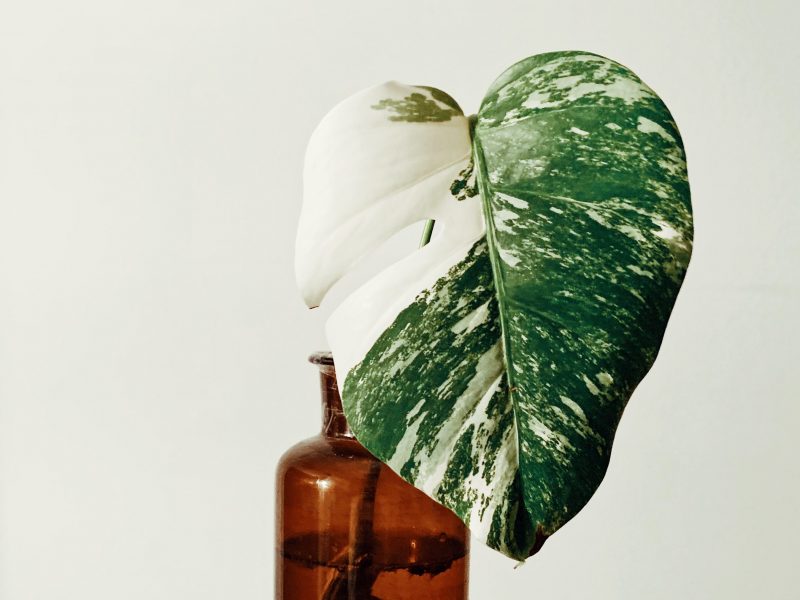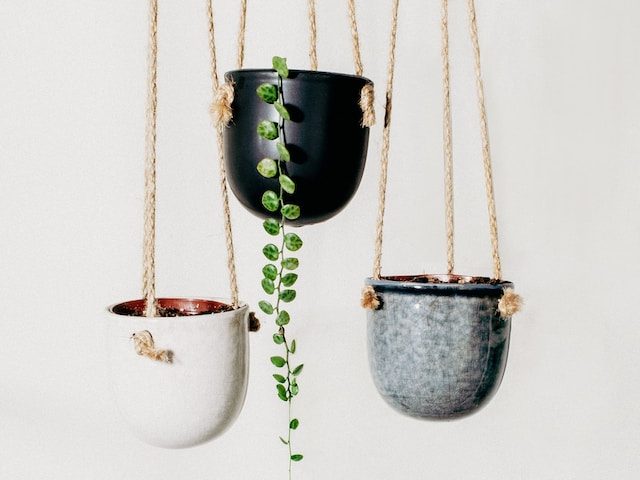
Monstera plants of all kinds have become increasingly popular in recent years due to their unique and striking appearance. Known and loved for their large, glossy split leaves, it’s often just the Monstera Deliciosa that gets all the love. However, there are many different types of Monsteras, each with their own unique characteristics and leaf patterns.
In this article, we will explore different types of Monsteras that are commercially available, from the common varieties to the rare and hard-to-find ones. Whether you’re a seasoned plant parent or just starting out, this guide will provide you with everything you need to know about the different types of Monstera plants.
Common Monstera Varieties
These you will often find easily in plant shops and nurseries around the whole. The high availability of these plants makes them a lot more affordable than the rarer varieties.

Monstera Deliciosa (Commonly known also as a Swiss Cheese Plant)
By far the most popular variety out there, the Monstera Deliciosa is what most people mean when they say Monstera! It has captured the hearts of plant owners across the world and established itself as the must-have indoor plant. It’s no surprise, with their incredible large split leaves.
Monstera Deliciosas are a very common houseplant to find in plant shops and nurseries and you can often get a relatively small one for a much more affordable price than several years ago. Whilst mature and variegated Monstera Deliciosas will set you back a good bit, they are fairly adaptable and less sensitive than a lot of other Monstera types so a great option for beginner and busy plant parents.
As you’ll find with a lot of Monstera types, the Monstera Deliciosa will eventually need a moss pole to thrive as in the wild they attach themselves onto other plants to stop themselves from drooping and falling over.
When it comes to propagating your Monstera Deliciosa, stem cuttings are a great way to do this and can have very high success rates. Unfortunately, you won’t be able to propagate through a single leaf though, so make sure each cutting includes a stem node.
You can learn more about this variety in our Monstera Deliciosa care guide.

Monstera Adansonii (Commonly known as the Monkey Mask Monstera)
The Monstera Adansonii is the second most common Monstera variety but is in fact very different to a Monstera Deliciosa. The Adansonii has smaller leaves and thinner stems and are often grown as hanging plants (they can be climbers too when attached to a moss pole).
The splits on the leaves of a Monstera Adansonii are very distinct which has led to a surge in popularity over the past couple of years.
They can be a little trickier to care for compared to the Deliciosa as they have much thinner leaves, making them more sensitive to changes in humidity and watering routines. However, with the right care, they will reward you with long vines with incredible leaves.
Find out more in our Monkey Mask Monstera care guide!

Rhaphidophora Tetrasperma (Commonly known as the Mini Monstera)
Love the leaves of a Monstera Deliciosa but just don’t have the space? Let us introduce you to the Rhaphidophora Tetrasperma which is known literally as the Mini Monstera! Native to Southeast Asia, they have the same incredible split heart-shaped leaves and the same care requirements but are much smaller.
Similarly to their larger counterpart, the Rhaphidophora Tetrasperma also needs a support stake as they will flop down without it. The Mini Monstera is also a relatively easy plant to care for, requiring bright, indirect light and regular watering.
Learn more in our Mini Monstera care guide!
Less Common Monstera Types
Although these can be a little trickier to find, they are often easily available online. It’s worth noting though that the majority of these types will be more expensive than the common varieties.
@visualgardenph on Instagram

Monstera Epipremnoides
The Monstera Epipremnoides is a relatively rare but highly sought-after Monstera variety. It looks quite like a Monkey Mask Monstera but has a lot larger splits and holes. The leaves are also loved for being a lot more elongated compared to other varieties.
One of the great things about the Monstera Epipremnoides is that it can be grown as a tall plant using a support stake or as a hanging vine, making it adaptable to the space in your home!
Monstera Epipremnoides needs a high humidity level to really thrive so a regular misting routine is a must with this type.
@urban_garden1.618 on Instagram

Monstera Karstenianum (Commonly known as the Monstera Peru)
The main difference with the Monstera Karstenianum is that they don’t actually develop fenestrated (split) leaves as a lot of other Monstera types do. Instead, they are known for their thick dark green patterned leaves. In fact, they almost look like a Peperomia variety!
The Monstera Karstenianum is quite a small plant and won’t ever grow beyond about 7 feet indoors and it’ll take a long time to get to that height so is a nice choice for smaller rooms. Their leaves also stay quite small, with a maximum of about 10 centimetres which makes them quite unique as a Monstera variety.
@therainyjungle on Instagram

Monstera Standleyana
Monstera Standleyana is one Monstera variety that not many have heard of and that doesn’t get enough credit in the houseplant world. They have very dark green shiny long and pointed leaves that are pretty unique for a type of Monstera!
You’ll also commonly find a variegated variety of the Monstera Standleyana which has incredible white spots, strokes and splashes which differs completely between each of the leaves. This makes for a really unique houseplant that’ll soon become the focal point of any room!
In terms of size, they won’t grow that large outside of their native habitat so will reach between 2-4 feet in your home. They can grow as climbers but also as hanging plants which makes them super versatile.
growurban.uk

Monstera Siltepecana (Commonly known as the Silver Monstera)
Sometimes mistaken for a Pothos Plant, the Monstera Siltepecana is one that you need to know about!! They are adored by many for their incredible silver heart-shaped leaves but the incredible thing is that they actually change depending on how they are grown.
If your Monstera Siltepecana is left to hang down and is not supported with a moss pole, then the leaves will remain in their juvenile state. This is where they are silver but still have relatively small leaves. When they are grown as climbers rather than hanging, their new leaves become bigger and bigger. However, the trade-off for this is that they become less silver and more solid green in colour.
@kebunbucorry on Instagram

Monstera Pinnatipartita
Native to the tropical rainforest of South America, the Monstera Pinnatipartita is quite an easy variety to care for. As with a lot of Monstera types, the Monstera Pinnatipartita does also have split leaves and whilst they aren’t as widespread across the plant, they do reach further up the leaf than a lot of other varieties.
It’s worth noting though that you will only see dramatic fenestration (splits) on mature leaves and you’ll notice that all of the younger leaves are solid with no holes. So this plant type definitely requires a little bit more patience to get the split leaves than other varieties.

Monstera Albo Variegata
Often dubbed as one of the most expensive houseplants around, the Monstera Variegata is a variegated version of the iconic Monstera Deliciosa. Not only are they rare to find, but a cutting could set you back a few hundred dollars, which makes getting the care and environment right even more important!
This type of variegated Monstera has stark white and green leaves, rather than speckles. This can result in large chunks of the leaf being white.
If you’re after a dramatic and striking houseplant then the Monstera Variegata is the one for you as they can grow up to 10 feet indoors!
The downside to a Monstera Albo Variegata is that they are genetically unstable. This means that when propagating them it’s not guaranteed that the leaves will also be variegated. It can also lose its variegation when growing new leaves.

Monstera Dubia (Commonly known as the Shingle Plant)
Similarly to the Monstera Siltepecana, the Monstera Dubia can also often be confused for a Pothos Plant as it has smaller leaves than the majority of other varieties and doesn’t have any splits in the leaves.
Native to the tropics of Central and South America, the Monstera Dubia is a climbing vine that supports itself on other houseplants in its native environment. This is why as a houseplant it needs to have a support stake to aid growth.
The interesting thing about the Monstera Dubia is that in the wild they can actually resemble the classic Monstera Deliciosa but as a houseplant don’t have the ability to grow beyond the juvenile stage of smaller solid leaves.
@gennasplants on Instagram

Monstera Obliqua
Out of the rarer Monstera varieties, the Monstera Obliqua is the most sought-after, leading to a high price tag. They are also one of the hardest Monstera types to care for so best left to seasoned plant professionals.
When it comes to spotting a Monstera Obliqua, you’ll often find that what you’re actually looking at is a wrongly labelled Monstera Adansonii. The thing to look for is that there is actually more hole than leaf, 90% is air rather than leaf.
You’ll also notice that the leaves are incredibly thin which will tell you a thing or two about their humidity and light requirements. It can be very difficult to get the care and environment right for the Monstera Obliqua as they need a constant high humidity level and absolutely no direct sunlight!
Rare Monstera Plant Types
These are some of the rarest Monstera plants available to buy and because of their rarity, they will set you back hundreds (and sometimes thousands) of dollars!
www.bybrittanygoldwyn.com

Monstera Esqueleto
Native to Costa Rica, Esqueleto means skeleton in Spanish which is where it gets its name!
The best way to think of a Monstera Esqueleto is that it’s a Monkey Mask Monstera with larger leaves and larger holes. Even indoors, the leaves on a Monstera Esqueleto can grow up to half a meter in length! Another way to tell the Monstera Esqueleto apart from the pack is that their leaves feel velvety in texture.
The good news is that although the Monstera Esqueleto is rare to find, it is now being produced more commercially so we expect the supply to increase over the next few years. This increased supply should also bring the price tag down a little bit so you’ll no longer have to reach deep into your pockets for even just a small cutting of this variety.
Monstera Thai Constellation Plant

Monstera Thai Constellation
The Monstera Thai Constellation is a variegated Monstera type with very fine speckles throughout the leaves. The great thing about this type is that genetically it is stable, which means it won’t lose the variegation when you propagate it.
Fun fact: The Monstera Thai Constellation was developed in a laboratory which means you aren’t able to cultivate it from a seed.
When looking for the perfect Monstera Thai Constellation, you want to choose one that has a medium level of variegation. Whilst every leaf will end up looking different, you don’t want too many leaves to be primarily white or yellow. This is because they don’t contain as much chlorophyll, preventing them from photosynthesising as much. Although it might be tempting to go for a primarily white plant, it can have its downsides.
@jungle_collective on Instagram

Monstera adansonii ‘Variegata’
This type of Monstera is a variegated version of the traditional Monstera adansonii. Like its non-variegated partner, it has relatively small leaves and thin stems (compared to other varieties).
The variegation tends to show up as half a white leaf and half a green leaf, rather than speckled variation across the plant. This can result in a really striking and unique appearance.
Although they are cheaper than a larger variegated Monstera variety, even a small cutting will cost several hundred dollars, with a mature plant reaching into the thousands.
Those are some of the most unique and striking Monstera varieties. Whilst some are very easy to find and relatively affordable, the rarer types can reach into the thousands when looking to purchase a mature plant. If you are after a rarer type, we recommend buying a cutting and growing it into a larger plant. It might take a few years but it will save you hundreds!














